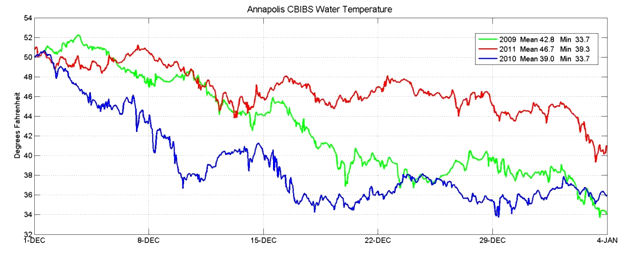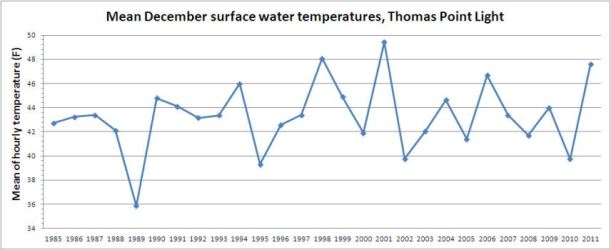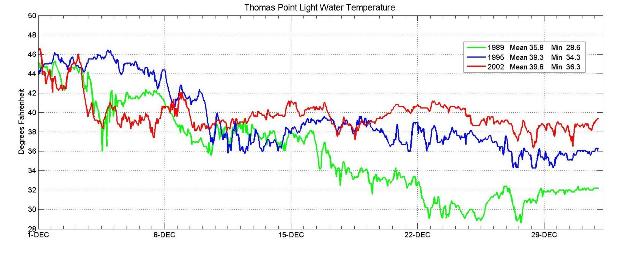Early last year (January 2011), roughly 2 million dead fish—primarily young spot—washed ashore in the mid Chesapeake Bay. CBIBS and other NOAA data showed an unusually fast drop in water temperatures in December 2010, which probably caused the fish kill; the annual blue crab winter dredge survey revealed that the cold snap was also likely to blame for a 30% mortality in blue crabs.
This winter, the water temperature data from December 2011 has good news for overwintering populations of fish and crabs, because the water was much warmer than it was in December 2009 and 2010. The graph below shows water temperatures at the CBIBS Annapolis buoy, with 2011 in red, 2010 in blue, and 2009 in green.

The very rapid drop in temperatures in early December 2010 is what is thought to have caused the fish kills; by late December 2010, temperatures were similar to those measured in 2009. In contrast, the 2011 December temperatures started out very similar to those in 2009, but instead of falling into the 40s at mid-month as in 2009, they did not drop significantly until January 2, 2012, when the air temperature dropped from 50 degrees Fahrenheit to below 35 F by the end of the day.
How Does This Compare to Past Years?
How does this variability from year to year in December temperatures compare to fluctuations in past years? Because December is often when temperatures drop to winter levels in this area, the variability seen in the winter of 2010 compared with that in 2011 appears to be within the normal range.
Because CBIBS buoys were only deployed in the past few years, they do not provide continuous water temperature records dating back decades. But data from the National Data Buoy Center buoy at Thomas Point Light just southeast of Annapolis shows that similarly high and low mean temperatures occurred every several years, as shown on this graph.

The last time December water temperatures were as warm as this year was in 2006, and the last time water temperatures were as cold as 2010 was in 2002. Some pairs of earlier years (1989-1990, 2000-2001, 2001-2002) saw even greater swings in December mean temperatures than the difference between 2010 and 2011.
Data from the three years between 1985 and 2010 with the coldest December water—1989, 1995, and 2002—shows that the temperature decline in those Decembers was much more gradual than it was in 2010. This graph shows the December water temperatures at Thomas Point Light in 1989 (green), 1995 (blue), and 2002 (red). The drop in water temperatures in 2010 (first graph above) is noticeably steeper than any of these three years, especially in the second week of December.

The water started a bit colder in all three years (about 45 F compared to 50 F in 2010), and 1989 also had a fairly rapid drop, but it was both smaller and later in the month than the one in 2010.
What Will Happen This Year?
What does this warm water mean for fish and crabs this winter? If it continues, it could increase their winter survival. But if there is another sudden cold snap, like the one in December 2010, there could be another fish and crab kill, especially if warm water has delayed their usual winter migrations.
Long-range forecasts for this winter from NOAA Climate Prediction Center indicate there is a 30 to 40% likelihood of above-average temperatures in the Bay watershed through March 15, and forecast average precipitation over that period.
Other Cold-Water Fish Kills
Two previous large winter fish kills—in January 1976 and January 1980—have been attributed to cold water stress, according to the Maryland Department of the Environment (MDE). However, both were before water temperature measurements started at Thomas Point Light. Fish kill data collected by MDE for 1985-2011 showed that while there were some January fish kills in years with colder-than-normal December water temperatures, none of them were as large as the December 2010-January 2011 kill. Other years, even those without colder-than-normal water temperatures, also had winter fish kills attributed to cold water. Rangia clams, originally from Louisiana, also had dieoffs in cold winters, notably in February 1996 after a cold December in 1995.
There were also fish kills that followed rapid temperature drops in years with normal mean December temperatures, including one in 1985 on a creek off the Susquehanna that followed a one-day drop in water temperature at Thomas Point on December 25 from 40 to 34 F.
Do December Water Temperatures Affect Overall Crab Numbers?
Annual blue crab population estimates can help scientists understand how December water temperatures might affect blue crabs. NCBO scientists calculated the percent change from year to year for both the annual crab populations and the annual mean December temperatures at Thomas Point Light. To make the years match up, the crab data was related to the temperature data for the previous year, so the years in the graph below refer to December temperatures in that year and the crab population from the following year (from later that same winter). This analysis, illustrated on the graph, shows:
- In several years, there was a positive correlation between the two measures, similar to what was noted for 2010. Years with colder or warmer December temperatures often had fewer or more crabs that winter, respectively, compared to the number of crabs the year before.
- But the expected pattern (seen when the two values were on the same side of the zero line) was seen in only 10 of 21 years, which suggests that if there is a causal link , other factors (such as harvest pressure and other climate factors) also affect the changes in crab populations.
- Therefore, while cold water in December is one factor that can lead to fish kills and lower blue crab populations, it is not the only factor that affects living resource populations in the Chesapeake Bay. Better understanding how fish, crabs, and other living resources respond to environmental conditions help decision makers manage resources more sustainably.



